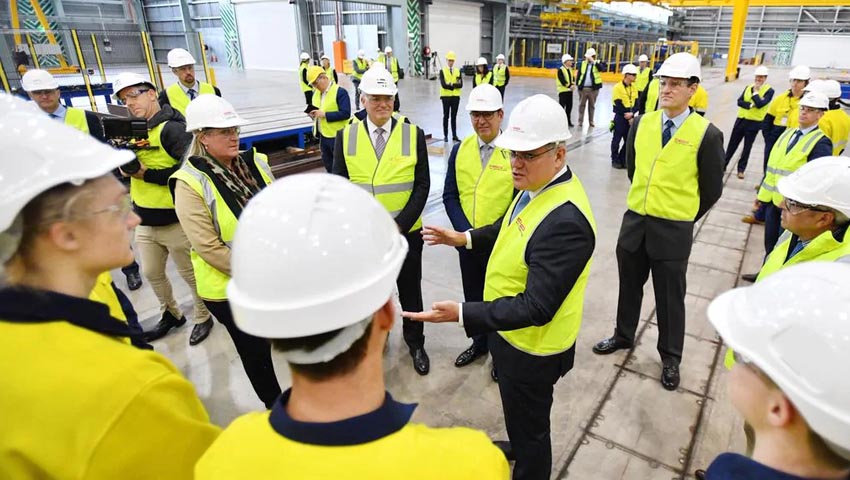Prime Minister Scott Morrison attended the recently completed Osborne South Development ahead of handover to ASC Shipbuilding, with the facilities expected to deliver a world-leading naval and shipbuilding industry hub and jobs boom for South Australia.
To continue reading the rest of this article, please log in.
Create free account to get unlimited news articles and more!
Australian engineering, design and advisory company Aurecon was the lead engineering and advisory consultant on the project, working in strong partnership with Australian Naval Infrastructure, Odense Marine Technologies and Lendlease.
The Osborne South Development Project is home to Australia’s two largest naval projects – the Collins Class submarine sustainment project and the Hobart Class air warfare destroyer project. The project is also the build location for the nation’s $50 billion Attack Class submarine program, the $35 billion Hunter Class frigate program as well as future frigate and future destroyer programs for continuous shipbuilding in Australia.
During construction, the Osborne South Development Project created close to 1,500 jobs and once fully operational it will employ approximately 5,000 people.
Aurecon managing director defence and national security ANZ, David Barnes, said that the Osborne South Development Project is crucial to support the growing capability of the Royal Australian Navy.
"Over 200 Aurecon engineers with deep technical knowledge from across the country came together over three years to help bring to life the colossal Osborne South Development project. Teamwork between Aurecon’s partners brought together significant interdisciplinary design experience that’s delivered a world-class facility capable of supporting Australia’s future shipbuilding program," Barnes explained.
Aurecon principal, infrastructure advisory and built environment, Niko Tsoukalas, said the shipbuilding hub’s enormous buildings and windy coastal location called for innovative engineering design.
Tsoukalas explained, "The largest steel structure on the site, B22 outfitting hall, is designed to house two ships side-by-side for construction – measuring 190 metres long, 90 metres wide and 50 metres high. That’s almost as large as the Adelaide Oval, and as tall as a 17-storey building.
"The design requirement to easily transport ships in and out of the building also meant that we had to engineer the building to accommodate an enormous 30 metres wide by 34 metres high ‘gigadoor’ – the size of which has never been seen in Australia before.
"Naturally, putting a door of that size into a building with a significant internal volume has the potential to create a resonance due to the wind effects – similar to when you open the car window while driving at high speed. This wind action can put further strain on the 4,000-tonne structure and its 6,500 steel members."
Prime Minister Scott Morrison said around 2,500 direct jobs would be created under the new frigate program, which now starts in December when the first steel is cut for prototyping.
"Our continuous naval shipbuilding program has changed the skyline at Osborne on the Port Adelaide River but importantly it’s delivering thousands of local jobs while boosting the economy and strengthening Australia’s defence capability," the Prime Minister said.
Tsoukalas added, "To overcome this challenge, we used advanced digital models and analysis to engineer the best and safest design solution. It’s been a fantastic project to be a part of, and it will be a real asset to our Navy and the local economy for many generations to come."
Over the next four months, ASC Shipbuilding will take control of the shipyard and start training their shipbuilders on the technology that has been installed for building warships efficiently and effectively.
Construction of the first of nine Hunter Class frigates is expected to begin on schedule in late 2022, this ship is expected to be delivered to Navy in 2029 – the ninth and final Hunter Class frigate is expected to be delivered to Navy in the mid-2040s.

 Login
Login







